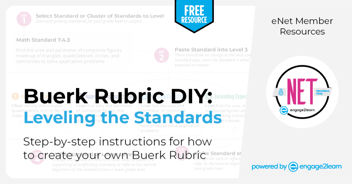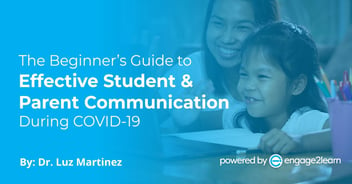Modeling Is Powerful: 5 Ways to Be Intentional | engage2learn
I still remember the first time I saw myself teaching: it was when I gave an assignment to my 11th graders to teach a math lesson to the class. As each “student teacher” proceeded with the lesson, he or she would use certain phrases, twirl a sharpie between his or her fingers, drop the chalk back and forth from hand to hand, ask lots of questions and answer those questions with more questions. There were giggles from classmates as these behaviors were demonstrated, and it finally dawned on me that they were imitating my unconscious behaviors. Some of these behaviors were positive attributes I had modeled, like encouraging all members of the class to engage in the discussion; other behaviors were completely unintentional. This was a great lesson for me as a first-year teacher to pay more attention to what I was modeling, and it was the first insight into a phenomenon I would study years later as I wrote the book on the 5 Leadership Levers for Intentionally Creating Culture…to be released in 2019.
Over the past few weeks, I have been reminded again of just how much an organization nearly always reflects the character and style of its leadership. I spent time with several, urban school district superintendents from across the country recently at the Council of the Great City Schools Fall Conference and noticed this playing out on more than one occasion.
I already knew this about our amazing partner districts in Texas, such as Arlington ISD, Dallas ISD, El Paso ISD, and Fort Worth ISD, who were all in attendance. It was interesting, however, to learn about new districts like Baltimore, Charlotte-Mecklenburg, Kansas City, Miami-Dade, Nashville, Portland, and San Diego and see the same dynamic. If the style, thinking, character, and conversation of the superintendent were innovative, visionary and forward-thinking, the staff conveyed the same sentiment, whether in formal presentations or informal conversation. Moreover, if that district superintendent seemed laser-focused, no-nonsense, and data-driven, the staff, and even students on the student panel, followed suit. Lastly, when the superintendent was clearly learner-centered, this was also evident in the conversation, goals, language, and programming of the district as a whole.
Similarly, I have noticed the same phenomenon with businesses we have had the opportunity to study up close, such as Google, Huckabee, Rackspace, Steelcase, TD Industries, and Whataburger. And at the Golden Bridge Awards in San Francisco this week, I saw it yet again. If the leader was quirky or conservative, professional or unprofessional, serious or fun-loving, the entire team echoed that bent as well. It was amazing to even note the style of dress being consistent across each organization, albeit unique to them.
Now, you may be thinking, “Of course, this makes sense that people in an organization follow the leader.” However, it is fascinating that many times, the leaders themselves are not being intentional about what they are modeling for their teams and are not cognizant of the implications of their actions, values, and habits. The message to leaders: be intentional about what you model!
There are lots of thought leaders who have written about this topic, but one of my new favorites is Brad Lomenick, author of H3 Leadership: Be Humble. Stay Hungry. Always Hustle. A quote from his work sums up the approach of intentional leadership: “A strong leader builds a habit of conviction, knowing that the times when no one is watching are when true character is built.”
In other words, you can’t fake it. If you want to elicit specific behaviors in your organization, you must be founded in them yourself and genuinely possess them in your own character. Without that level of conviction, the phenomenon still rings true, and the natural behaviors of a leader’s true personality are going to drive the organizational culture.
You can’t fake it. If you want to elicit specific behaviors in your organization, you must be founded in them yourself and genuinely possess them in your own character. Click To TweetSo, how can a leader be intentional about modeling behaviors that foster a thriving organizational culture? Here are 5 actionable ways:
1. Define the desired behaviors, collaboratively, aligned to shared beliefs.
For example, see Arlington ISD’s Cultural Tenets below and our own e2L Cultural Tenets here. Reach out if you want a tool like the one we used in Arlington to help them to define their Cultural Tenets!
2. Self-assess, set personal goals, and reflect regularly on your application of these behaviors.
I love the example of Preston Atkinson, the CEO for Whataburger. He showed us his pocket card of the Whataburger Core Values and told us that he reads them every morning to prepare for the day and again at the end of the day to reflect upon his actions, especially those from crucial conversations.
3. Recognize or reward these behaviors throughout the organization.Create aligned recognition systems and ensure that your current reward systems are not in conflict with the desired behaviors. For example, many district leaders have found that their Teacher of the Year programs are rewarding but not aligned to the essential behaviors for that district.
What about creating a badging system that aligns to your desired behaviors? Our e2L badging system for Life Ready Best Practices is quite motivating for teachers and leaders, as it defines behaviors and rewards incremental progress.
4. Check your meeting protocols and align those to the desired behaviors.
This is a gut-check on how intentional we are being with our desired behaviors! For example, we say that we value collaboration, yet our meetings consist of one-way information sharing. You can design a template for meeting agendas to incorporate those desired behaviors, and this one action will permeate the organization.
5. Design spaces and furniture to facilitate desired behaviors.
This is something a leader can control, and we know that spaces “tell us” how to act. It doesn’t need to cost a lot of money to intentionally design interiors that create a tone aligned to desired behaviors, and it is a very tangible, visual signal of the culture. For example, re-organize office furniture or paint the walls of a Boardroom or professional learning space with whiteboard paint to increase interactivity.
The revered adage from Mahatma Gandhi encompasses this call to action for leaders: “Be the change you want to see in the world.” Click To TweetThe revered adage from Mahatma Gandhi encompasses this call to action for leaders: “Be the change you want to see in the world.” To evoke the behaviors you desire within your school district or organization, you must first embody them yourself and model them tirelessly. Before you know it, those intentional behaviors will become the lifeblood of your organizational culture.




